Iterative Method for Tuning Multiloop PID Controllers Based on Single Loop Robustness Specifications in the Frequency Domain
Abstract
:1. Introduction
2. Preliminary Background
2.1. Effective Open Loop Processes
2.2. SISO PID Tuning Methods and Robutstness Specifications
2.2.1. PID Tuning by Moving a Point of the Nyquist Diagram
2.2.2. PID Tuning by Linear Programming
3. Proposed Methodology
3.1. Phase Margin Case
- Given the frequency response array of the EOP obtain the design frequency range for which the tuning of PID controller parameters is possible according to the argument condition in (10). The phase provided by the controller must be in the range from −90 to 90°.
- Determine the magnitude and phase contributions of the controller according to (13) for each possible design frequency ωk.
- Calculate the PID parameters according to (15) for each frequency ωk. As a result, as many PID control candidates as design frequencies are obtained.
- Evaluate stability of each design and choose that one with the greatest integral gain.
3.2. Gain Margin Case
3.3. Combined Phase and Gain Margin Case
- First, the current relaxed phase margin specification is initialized to the original one This phase margin will be relaxed if it is necessary. The gain margin specification will remain the same.
- Given the EOP obtain the design range of frequencies ωk, which allows the solution to the PID control tuning for the current phase margin according to the argument condition in (10). This step is similar to that of the tuning procedure in the phase margin case. Note that and are still the same.
- Calculate a PID controller kk for each frequency ωk using as the specification. It is also analogous to the tuning procedure described in the phase margin case. A set of PID controllers is obtained with the size of the design frequencies array.
- Evaluate the cost index Jk in (29) for each design kk analyzing Select the PID design with the minimum cost index Jk. This defines the current lowest index JC and its corresponding PID controller kC.
- If the cost index JC is below a user-defined tolerance, the original specifications and are assumed to be achieved, the current PID control design is accepted, and the algorithm finishes without relaxing the phase margin specification. Otherwise it is necessary to enter in the main part of the flow diagram, which decides how to relax the phase margin requirement.
- The first time the procedure enters here, no information is available to decide whether the current relaxed margin specification must be relaxed by increment or decrement. Therefore, the steps from 2 to 4 are repeated for both higher and lower values of . A variation of ±1 is considered adequate as a tradeoff between accuracy and speed. Then, both branches of the main part of the flow diagram are executed simultaneously; in practice one branch is performed before the other being the order irrelevant. The left branch develops the PID designs for and evaluates each cost index Jk using the original specifications and The minimum cost index is defined as J− and the associated PID controller as k−. Similarly, the right branch performs the PID designs for obtaining the best PID controller k+ with the corresponding minimum cost index J+.
- Determine the search path by means of the three cost indices J−, JC and J+. There are three possibilities:
- If JC is the minimum cost index, the best solution is achieved using the current relaxed phase margin with the PID controller kC, and the procedure finishes.
- If J+ is the minimum cost index, the design is improved by incrementing the current relaxed phase margin, so is incremented, and the procedure enters the loop of the right branch. As has been updated, some cost indices and their corresponding PID controllers must be also updated accordingly as follows: J− = JC, k− = kC, JC = J+ and kC = k+. Next, the new index J+ and controller k+ are calculated following again the right branch steps.
- If J− is the minimum cost index, the design is improved by decrementing the relaxed phase margin, and the algorithm follows the loop of the left branch. Consequently, cost indices and their corresponding PID controllers are updated as follows: J+ = JC, k+ = kC, JC = J− and kC = k−. Then, the new index J− and controller k− are obtained after the branch steps.
- The process iterates into the branch determined in the previous step until no improvement is obtained in the cost index. Then, JC results in the minimum cost index, its associated PID controller kC is selected as the final one and the procedure ends.
3.4. Sensitiviy Margin Case
- First, the current relaxed angle θC is initialized to the original one θ. This angle θC will be relaxed if needed and will be provided as an algorithm output.
- Given the obtain the design range of frequencies ωk, which allows one to find a solution for the PID control tuning given the sensitivity margin and angle θC according to the argument condition in (10). For this, it is necessary to calculate the magnitude and phase of L(jω) at the tangency point by means of (16) and (17).
- Calculate a PID controller kk for each frequency ωk using and θC as specifications. First, the argument and phase to be provided by the controller are computed from (18); then, using expressions in (15), a set of PID controllers is obtained as large as the size of the design frequency array.
- Evaluate the tangency condition function TCFk in (19) for each Among all designs with TFCk below a user-defined tolerance tolTC, the one with maximum integral gain KI for improving load disturbance rejection is selected. This defines the PID controller kC. The sensitivity margin Ms of is evaluated and the corresponding cost index JC is calculated using (30).
- If the cost index JC is below a user-defined tolerance, the specification is achieved with the original angle θ, the current PID control design is acceptable, and the algorithm ends without relaxing the angle θC. Otherwise it is necessary to enter in the main part of the flow diagram, which decides how to relax this angle.
- In similar way to the algorithm proposed in Section 3.3, the procedure needs more information to whether the relaxed angle θC must be incremented or decremented. Therefore, steps from 2 to 4 are repeated for θC+ 1 and θC − 1. The left branch performs the PID designs for θC − 1 obtaining the PID controller k− and its corresponding cost index J−. The right branch develops the PID designs for θC + 1 providing the PID controller k+ with the corresponding cost index J+.
- Determine the search path by means of the three cost indices J−, JC and J+. There are three possibilities:
- If JC is the minimum cost index, the best solution is achieved using the current relaxed angle θC with the PID controller kC, and the procedure finishes.
- If J+ is the minimum cost index, the tuning is improved incrementing the relaxed angle, so θC is incremented, and the process enters the loop of the right branch. Since θC has been updated, some cost indices and their corresponding PID controllers must be also updated accordingly as follows: J− = JC, k− = kC, JC = J+ and kC = k+. Next, the new index J+ and controller k+ are obtained following again the right branch steps.
- If J− is the minimum cost index, a decrease in θC improves the PID design, so it is decremented, and the algorithm follows the loop of the left branch. This θC modification entails the update of the following indices and associated controllers: J+ = JC, k+ = kC, JC = J− and kC = k−. Then, the new index J− and controller k− are obtained after the left branch steps.
- The process iterates into the branch determined in the previous step until no improvement is achieved in the cost index. Then, JC results in the minimum cost index and the procedure ends. The algorithm provides as outputs the associated PID controller kC and the relaxed angle θC to be used as input in the following iteration step of the general multiloop design procedure.
3.5. Linear Margin Case
4. Illustrative Examples
4.1. Wood and Berry Distillation Column
- Phase margin case: ϕm = 45° in both loops.
- Gain margin case: Am = 3 in both loops.
- Combined phase margin and gain margin case: ϕm = 45° and Am = 3 in both loops.
- Sensitivity margin case: Ms = 1.68 and initial θ = 25° in both loops.
- Linear margin case: ℓ = 0.67 and α = 62° in both loops.
4.2. Ogunnaike and Ray Distillation Column
5. Conclusions
- Phase margin or gain margin cases: the proposed SISO PID tuning method is based on moving a point of the EOP Nyquist diagram to a desired one of the open loop L(jω) fulfilling the specified margin and providing the maximum possible integral gain.
- Combined phase margin and gain margin case: a new PID tuning method is proposed based on the previous cases. Since achieving both margins simultaneously is not always possible, this method relaxes the phase margin specification in one direction by means of an iterative path-following algorithm until no improvement is achieved in a defined cost index that combines both margins.
- Sensitivity margin case: a new PID tuning method is also proposed for this case. It is based again on moving a point of the Nyquist diagram to fulfill the specification. The algorithm receives as inputs the sensitivity margin Ms and angle θ at the tangency point, which can be relaxed in similar way to the previous case. In the method this angle is relaxed if needed to achieve a suitable design fulfilling properly the tangency condition and maximizing the integral gain.
- Linear margin case: the proposed PID tuning method performs a loop shaping of L(jω) approaching it as a linear optimization problem. It ensures that the Nyquist diagram of L(jω) is below a line r and maximizes the integral gain. In this work a new cost index based on the distance of the Nyquist plot to the line r is proposed to determine when the algorithm ends.
Author Contributions
Funding
Data Availability Statement
Conflicts of Interest
References
- Garrido, J.; Ruz, M.L.; Morilla, F.; Vázquez, F. Interactive tool for frequency domain tuning of PID controllers. Processes 2018, 6, 197. [Google Scholar] [CrossRef] [Green Version]
- Bristol, E. On a new measure of interaction for multivariable process control. IEEE Trans. Autom. Control 1966, 11, 133–134. [Google Scholar] [CrossRef]
- Garrido, J.; Vázquez, F.; Morilla, F. Multivariable PID control by decoupling. Int. J. Syst. Sci. 2016, 47, 1054–1072. [Google Scholar] [CrossRef]
- Garrido, J.; Vázquez, F.; Morilla, F.; Normey-Rico, J.E. Smith predictor with inverted decoupling for square multivariable time delay systems. Int. J. Syst. Sci. 2016, 47, 374–388. [Google Scholar] [CrossRef] [Green Version]
- Luyben, W.L. Simple Method for Tuning SISO Controllers in Multivariable Systems. Ind. Eng. Chem. Process Des. Dev. 1986, 25, 654–660. [Google Scholar] [CrossRef]
- Chiu, M.S.; Arkun, Y. A methodology for sequential design of robust decentralized control systems. Automatica 1992, 28, 997–1001. [Google Scholar] [CrossRef]
- Hovd, M.; Skogestad, S. Sequential design of decentralized controllers. Automatica 1994, 30, 1601–1607. [Google Scholar] [CrossRef]
- Wang, Q.-G.; Lee, T.-H.; Zhang, Y. Multi-Loop Version of the Modified Ziegler-Nichols Method. IFAC Proc. Vol. 1999, 32, 6848–6853. [Google Scholar] [CrossRef]
- Mahapatro, S.R.; Subudhi, B. A Robust Decentralized PID Controller Based on Complementary Sensitivity Function for a Multivariable System. IEEE Trans. Circuits Syst. II Express Briefs 2020, 67, 2024–2028. [Google Scholar] [CrossRef]
- Bao, J.; Forbes, J.F.; McLellan, P.J. Robust multiloop PID controller design: A successive semidefinite programming approach. Ind. Eng. Chem. Res. 1999, 38, 3407–3419. [Google Scholar] [CrossRef]
- Boyd, S.; Hast, M.; Åström, K.J. MIMO PID tuning via iterated LMI restriction. Int. J. Robust Nonlinear Control 2016, 26, 1718–1731. [Google Scholar] [CrossRef]
- Morales, D.C.; Jiménez-Hornero, J.E.; Vázquez, F.; Morilla, F. Educational tool for optimal controller tuning using evolutionary strategies. IEEE Trans. Educ. 2012, 55, 48–57. [Google Scholar] [CrossRef]
- Reddy, M.D.L.; Padhy, P.K.; Ahmad Ansari, I. Auto-tuning method for decentralized PID controller of TITO systems using firefly algorithm. In Proceedings of the 2019 International Conference on Intelligent Computing and Control Systems (ICCS), Madurai, India, 15–17 May 2019; pp. 683–688. [Google Scholar] [CrossRef]
- Vu, T.N.L.; Lee, J.; Lee, M. Design of multi-loop PID controllers based on the generalized IMC-PID method with Mp criterion. Int. J. Control. Autom. Syst. 2007, 5, 212–217. [Google Scholar]
- He, M.J.; Cai, W.J.; Wu, B.F. Design of decentralized IMC-PID controller based on dRI analysis. AIChE J. 2006, 52, 3852–3863. [Google Scholar] [CrossRef]
- Chen, D.; Seborg, D.E. Design of decentralized PI control systems based on Nyquist stability analysis. J. Process Control 2003, 13, 27–39. [Google Scholar] [CrossRef]
- Zhang, Y.; Wang, Q.-G.; Astrom, K.J. Dominant pole placement for multi-loop control systems. Automatica 2002, 38, 1213–1220. [Google Scholar] [CrossRef]
- Huang, H.P.; Jeng, J.C.; Chiang, C.H.; Pan, W. A direct method for multi-loop PI/PID controller design. J. Process Control 2003, 13, 769–786. [Google Scholar] [CrossRef]
- Vu, T.N.L.; Lee, M. Multi-loop PI controller design based on the direct synthesis for interacting multi-time delay processes. ISA Trans. 2010, 49, 79–86. [Google Scholar] [CrossRef]
- Nandong, J.; Zang, Z. Multi-loop design of multi-scale controllers for multivariable processes. J. Process Control 2014, 24, 600–612. [Google Scholar] [CrossRef] [Green Version]
- Nie, Z.-Y.; Wang, Q.-G.; Wu, M.; He, Y. Tuning of multi-loop PI controllers based on gain and phase margin specifications. J. Process Control 2011, 21, 1287–1295. [Google Scholar] [CrossRef]
- Vázquez, F.; Morilla, F.; Dormido, S. An iterative method for tuning decentralized PID controllers. IFAC Proc. Vol. 1999, 32, 1501–1506. [Google Scholar] [CrossRef]
- Morilla, F.; Dormido, S. Methodologies for the Tuning of PID Controllers in the Frequency Domain. IFAC Proc. Vol. 2000, 33, 147–152. [Google Scholar] [CrossRef]
- Ho, W.K.; Lee, T.H.; Gan, O.P. Tuning of Multiloop PID Controllers Based on Gain and Phase Margins Specifications. IFAC Proc. Vol. 1996, 29, 6007–6012. [Google Scholar] [CrossRef]
- Zhu, Z.X. Structural analysis and stability conditions of decentralized control systems. Ind. Eng. Chem. Res. 1996, 35, 736–745. [Google Scholar] [CrossRef]
- Vilanova, R.; Alfaro, V.M. Control PID Robusto: Una visión panorámica. RIAI Rev. Iberoam. Autom. E Inform. Ind. 2011, 8, 141–158. [Google Scholar] [CrossRef] [Green Version]
- Karimi, A.; Kunze, M.; Longchamp, R. Robust controller design by linear programming with application to a double-axis positioning system. Control Eng. Pract. 2007, 15, 197–208. [Google Scholar] [CrossRef]
- Dormido, S.; Morilla, F. Tuning of PID Controllers Based on Sensitivity Margin Specification. In Proceedings of the 5th Asian Control Conference (IEEE Cat. No.04EX904), Melbourne, Victoria, Australia, 20–23 July 2004; pp. 486–491. [Google Scholar]
- Vu, T.N.L.; Lee, M. Independent Design of Multi-loop PI/PID Controllers for Multi-delay Processes. World Acad. Sci. Eng. Technol. 2009, 703–708. [Google Scholar] [CrossRef]
- Euzébio, T.A.M.; Yamashita, A.S.; Pinto, T.V.B.; Barros, P.R. SISO approaches for linear programming based methods for tuning decentralized PID controllers. J. Process Control 2020, 94, 75–96. [Google Scholar] [CrossRef]
- Wood, R.K.; Berry, M.W. Terminal composition control of a binary distillation column. Chem. Eng. Sci. 1973, 28, 1707–1717. [Google Scholar] [CrossRef]
- Åström, K.J.; Hägglund, T. Advanced PID Control; ISA-The Instrumentation, Systems, and Automation Society: Research Triangle Park, NC, USA, 2005. [Google Scholar]
- Ogunnaike, B.A.; Lemaire, J.P.; Morari, M.; Ray, W.H. Advanced multivariable control of a pilot-plant distillation column. AIChE J. 1983, 29, 632–640. [Google Scholar] [CrossRef]
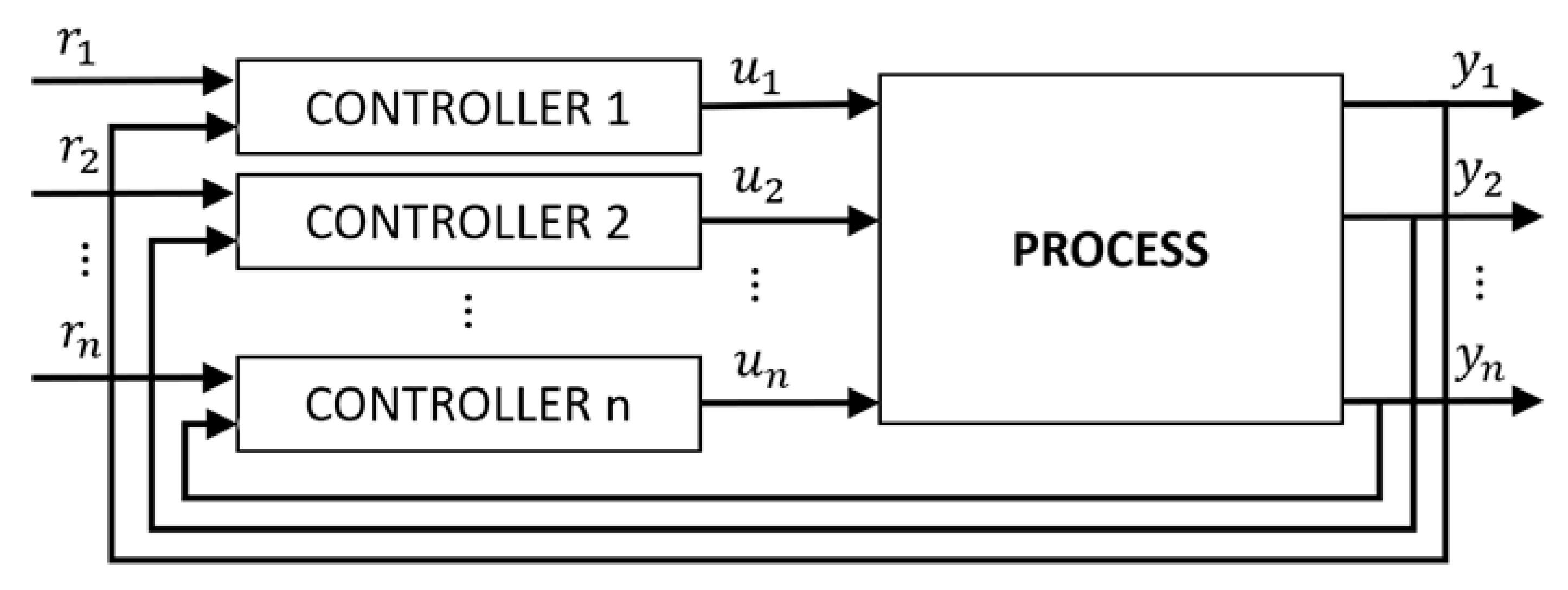
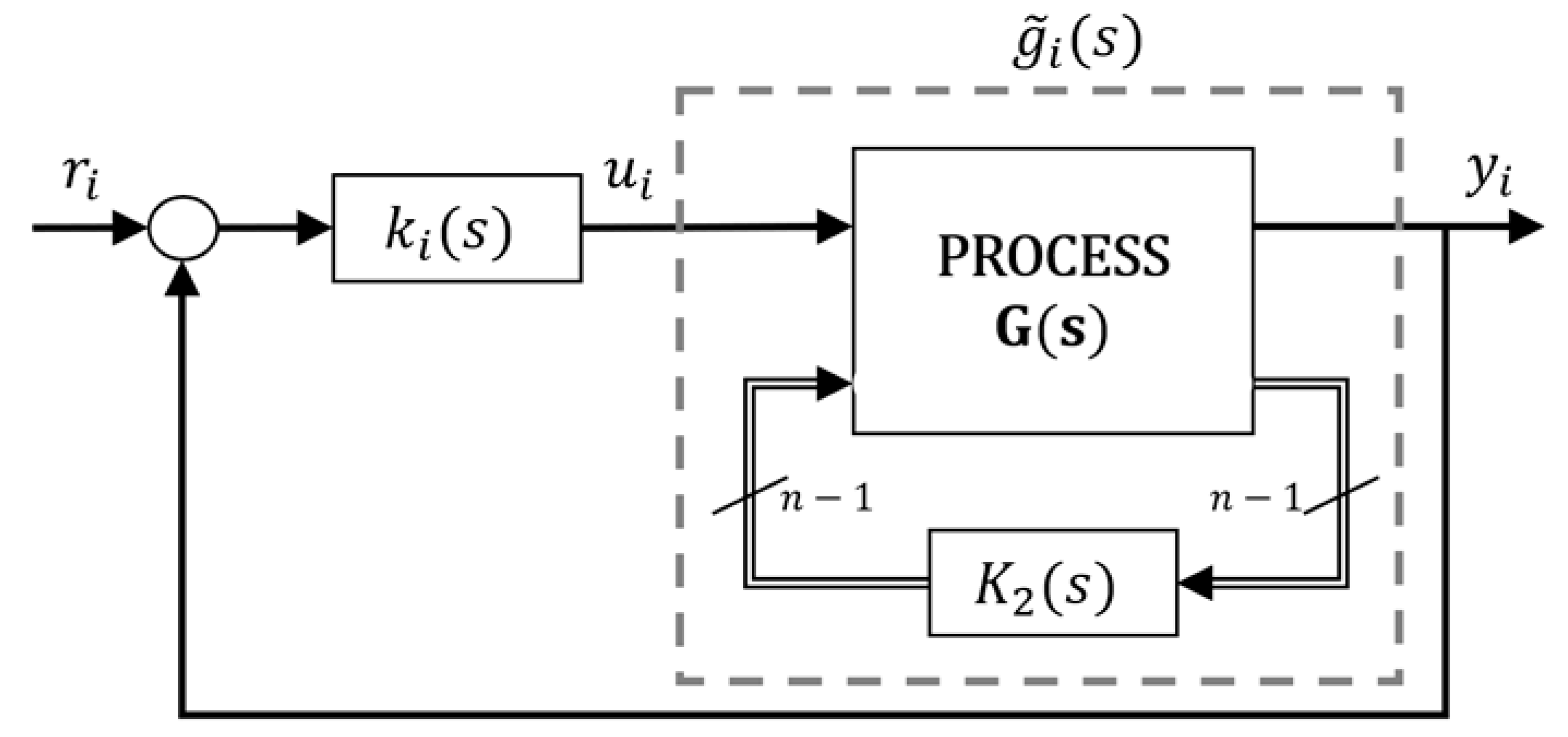
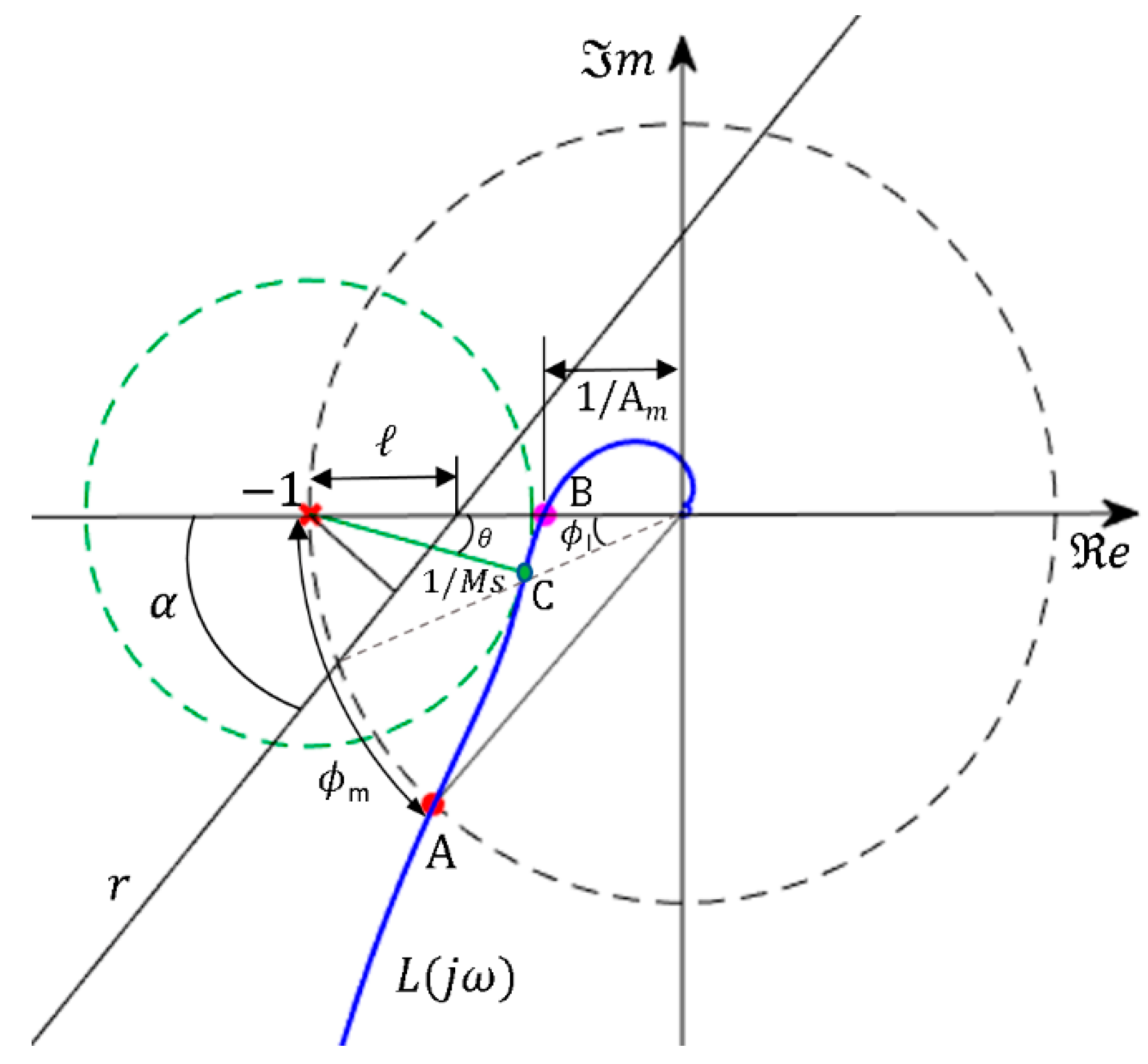


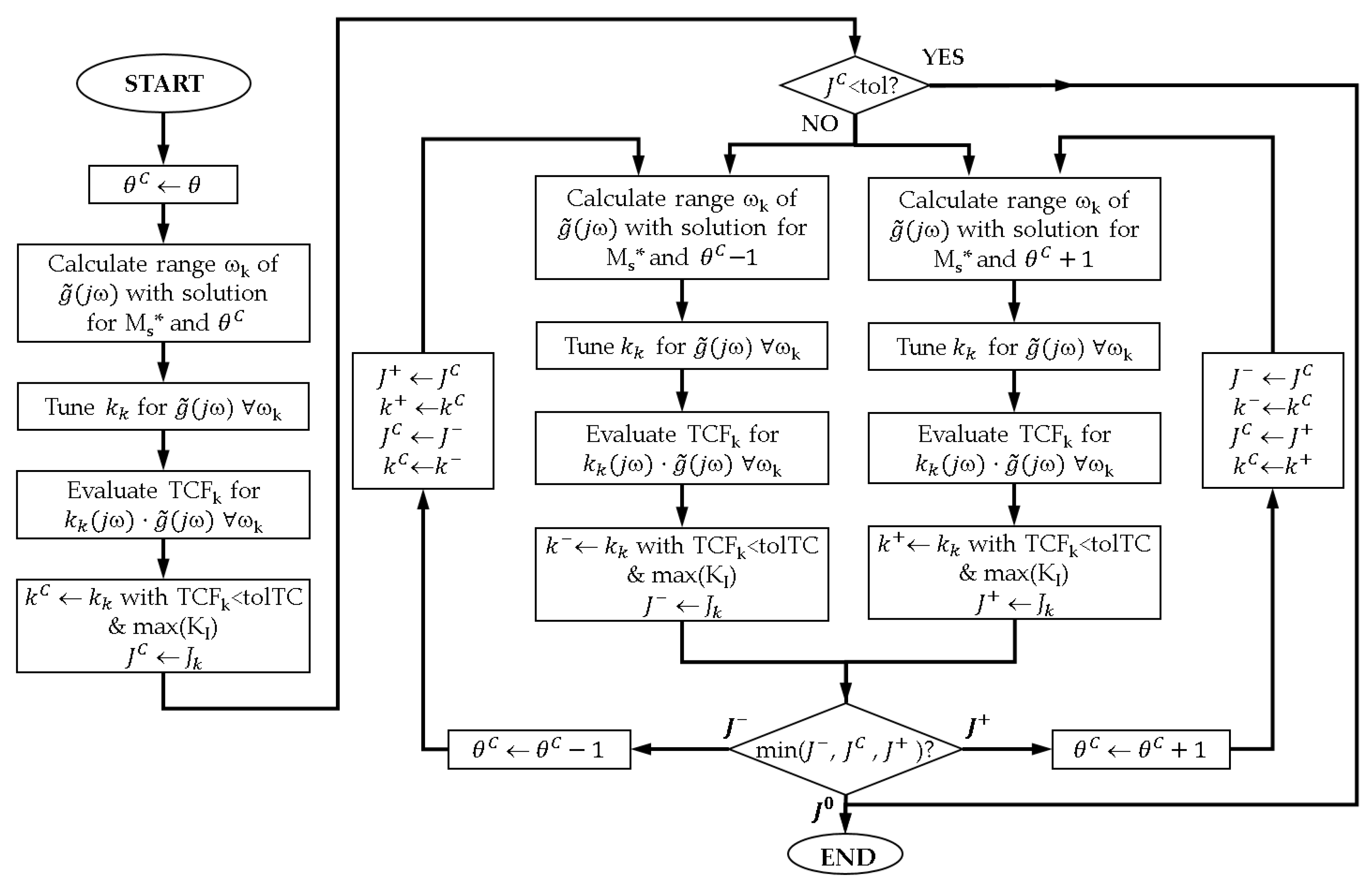


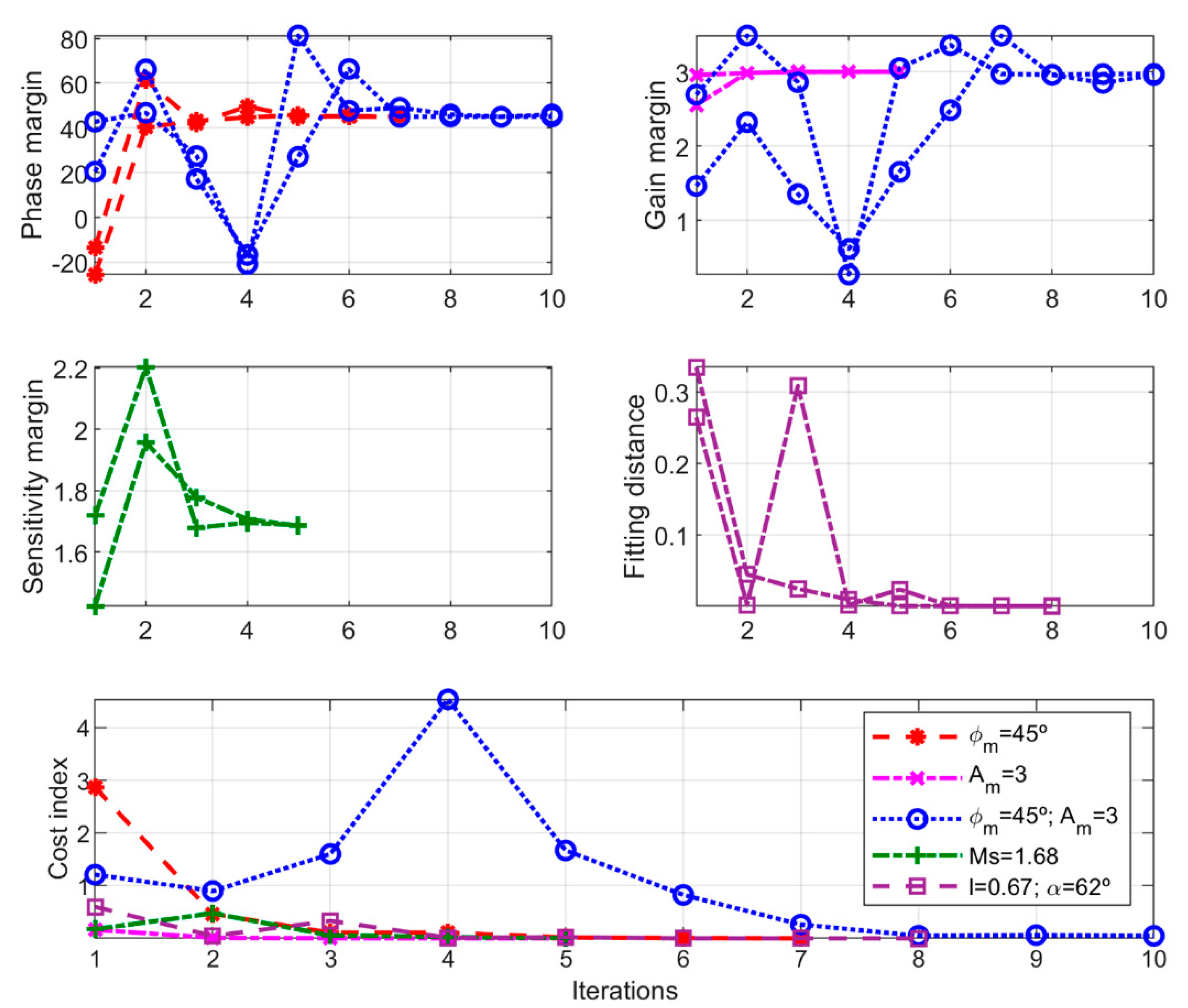
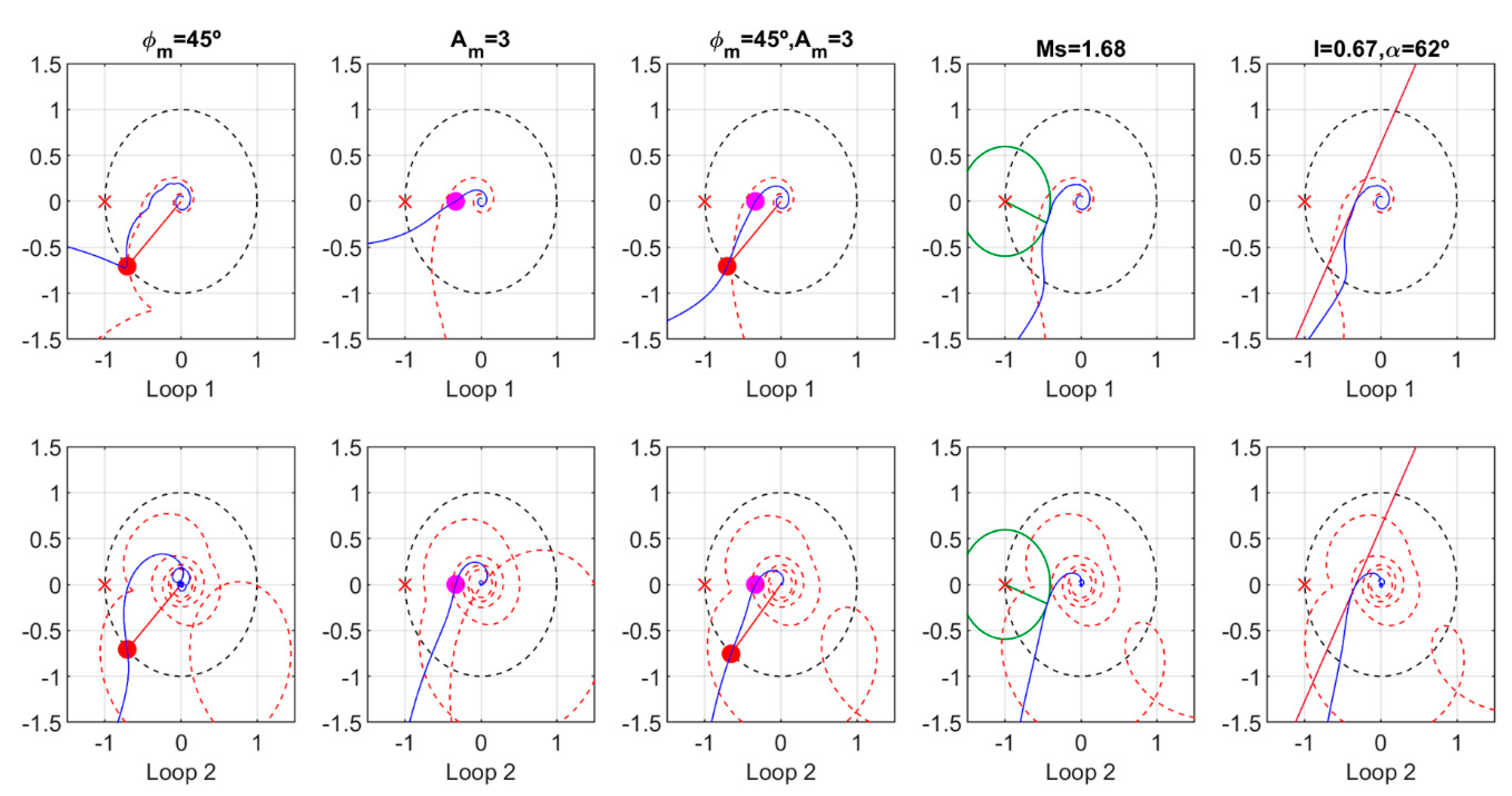
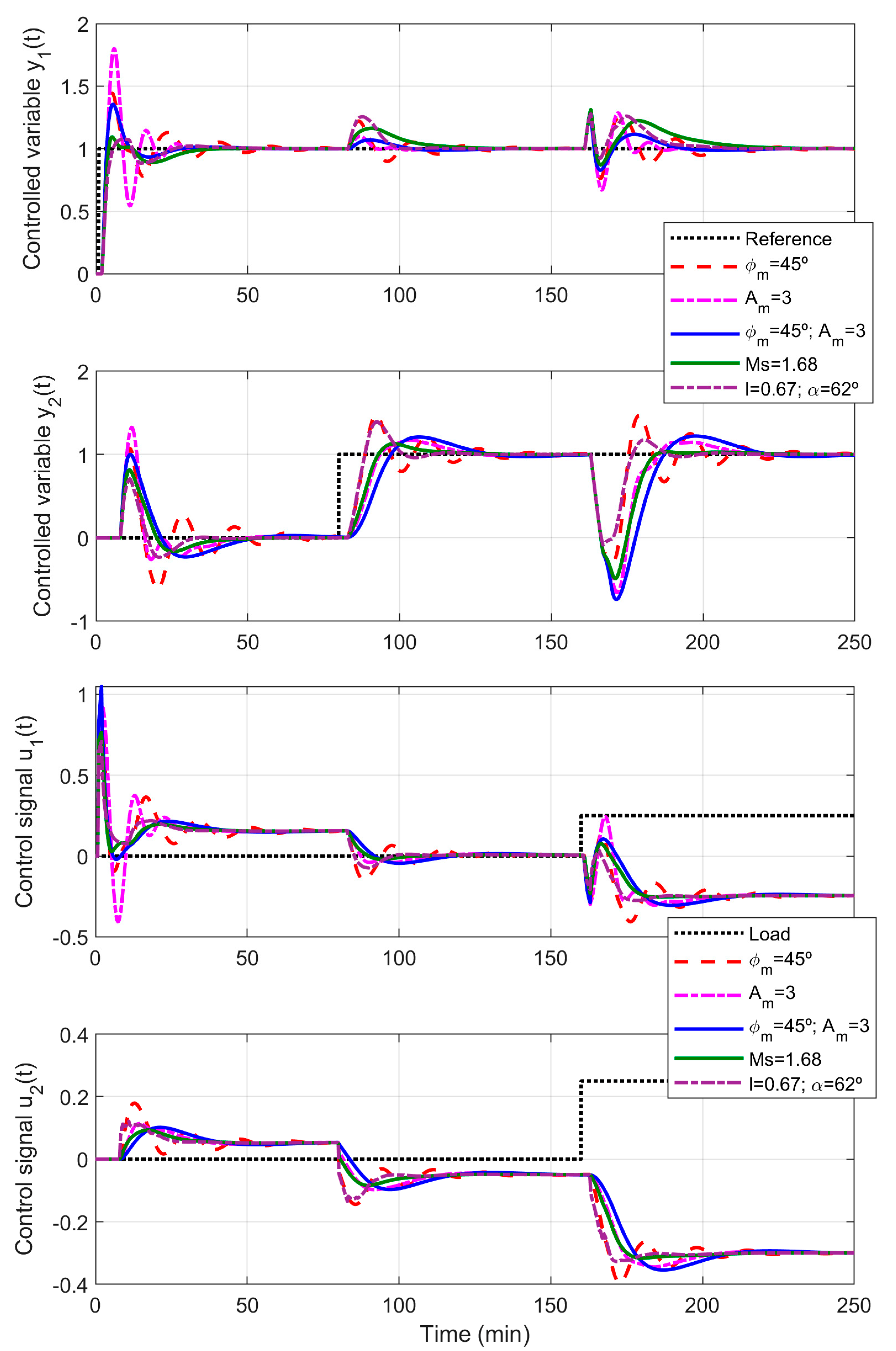


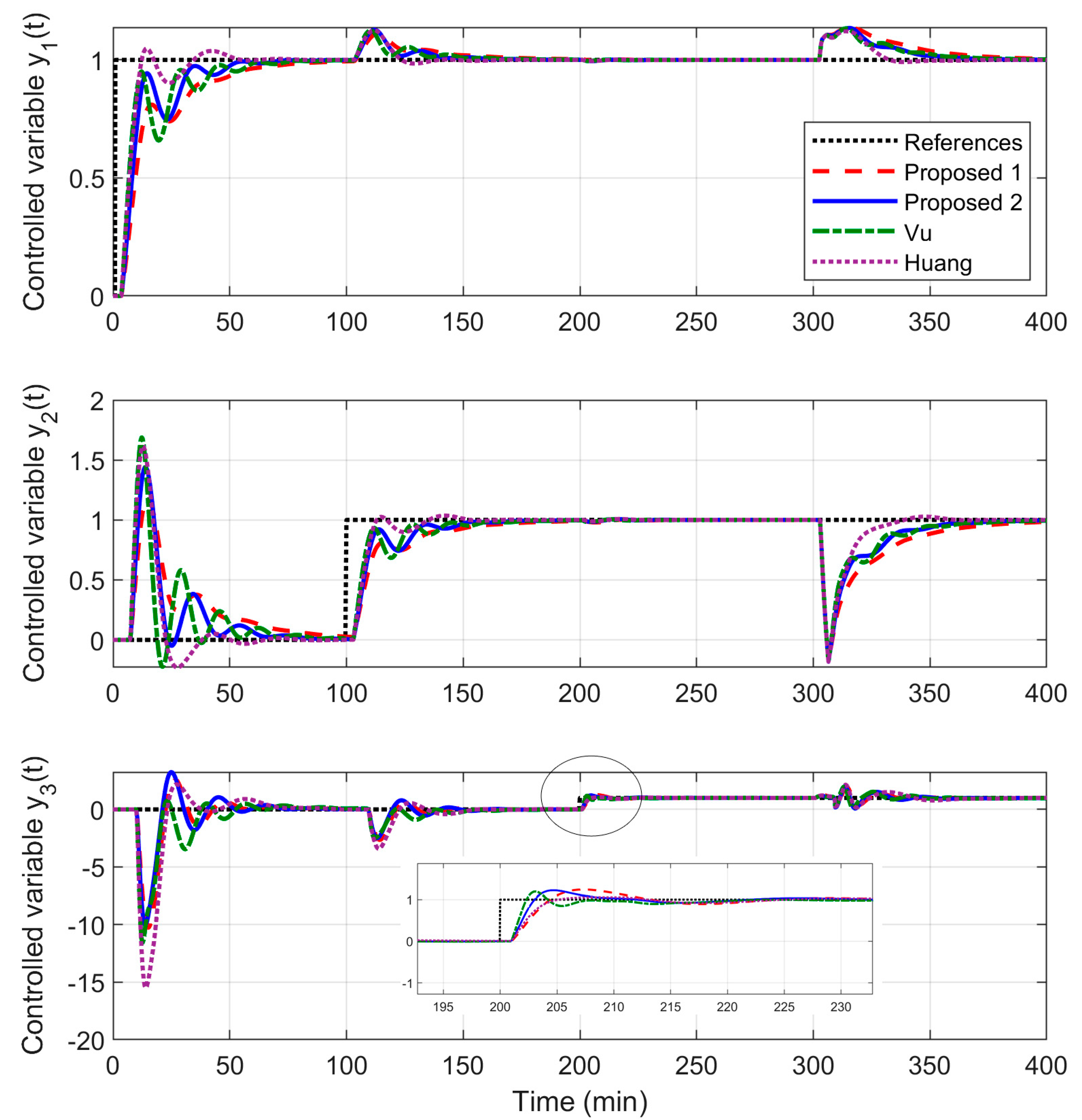
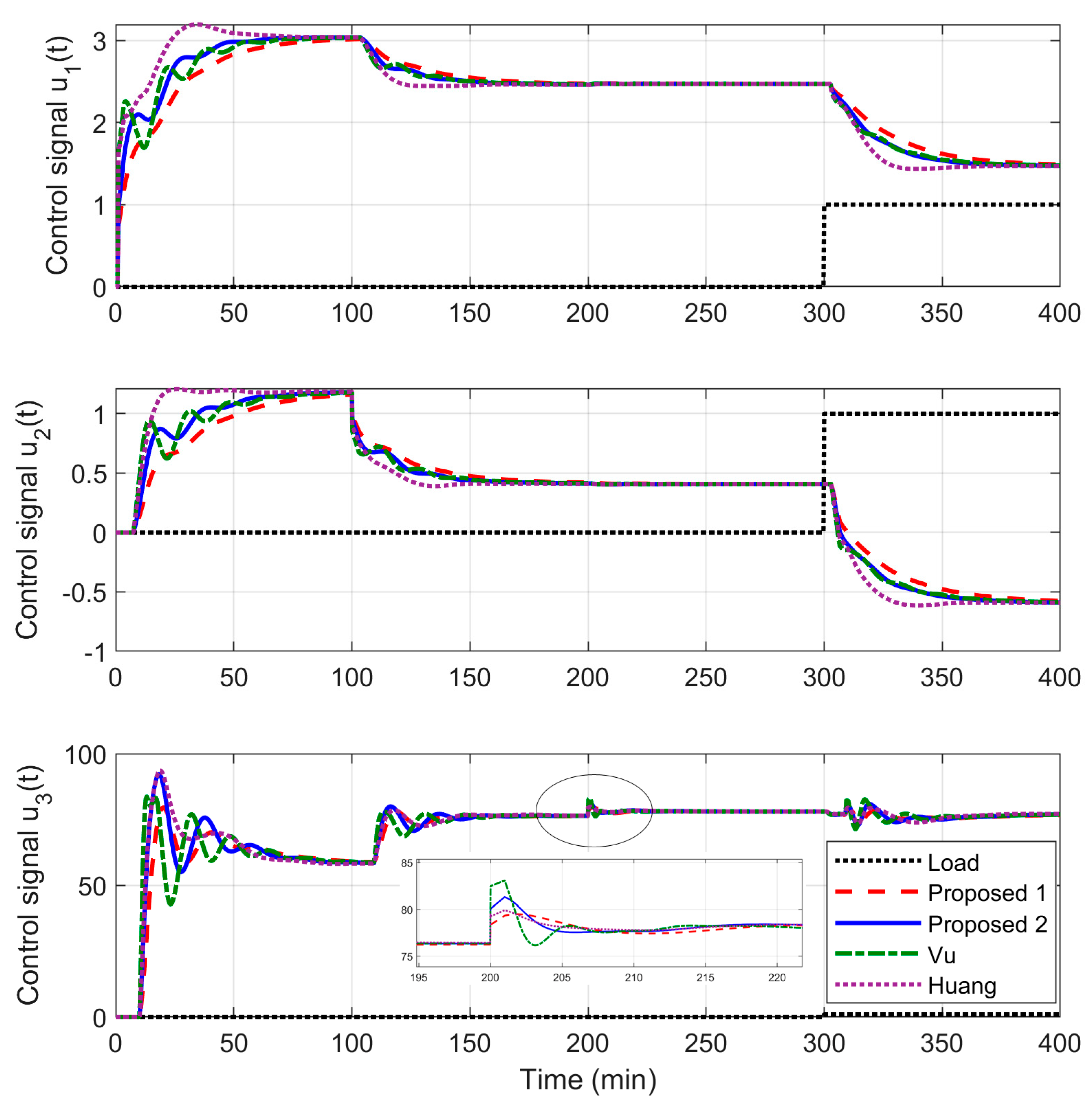
| Specifications in Both Loops | KP | KI | KD | ϕm | Am | Ms | ωcp (rad/min) | IAE | TV | |
|---|---|---|---|---|---|---|---|---|---|---|
| ϕm = 45° | loop 1 | 0.732 | 0.206 | 0 | 45 | 2.5 | 2.24 | 0.57 | 13.3 | 5.85 |
| loop 2 | −0.0888 | −0.029 | 0 | 45 | 1.5 | 3.4 | 0.23 | 42.6 | 1.74 | |
| Am = 3 | loop 1 | 0.564 | 0.3744 | 0.085 | 18.3 | 3 | 3.3 | 0.61 | 10.9 | 5.43 |
| loop 2 | −0.025 | −0.0172 | −0.0036 | 49.6 | 3 | 1.59 | 0.12 | 42.3 | 0.74 | |
| ϕm = 45° and Am = 3 | loop 1 | 0.8066 | 0.2418 | 0.27 | 45.1 | 2.97 | 1.6 | 0.65 | 8.1 | 3.9 |
| loop 2 | −0.0018 | −0.0138 | 0.0 | 46 | 2.96 | 1.68 | 0.1 | 54.2 | 0.75 | |
| Ms = 1.68 | loop 1 | 0.714 | 0.0512 | 0 | 61.7 | 2.8 | 1.687 | 0.51 | 12.3 | 2.82 |
| loop 2 | −0.0418 | −0.0161 | 0 | 55.6 | 2.9 | 1.685 | 0.13 | 34.9 | 0.59 | |
| ℓ = 0.67 and α = 62° | loop 1 | 0.65 | 0.064 | 0.26 | 59.4 | 3.2 | 1.49 | 0.45 | 10.5 | 2.72 |
| loop 2 | −0.093 | −0.032 | −0.176 | 47.2 | 3.6 | 1.68 | 0.22 | 25.5 | 0.89 | |
| Specifications in Each Loop | KP | KI | KD | ϕm | Am | Ms | ωcp (rad/min) | IAE | TV | |
|---|---|---|---|---|---|---|---|---|---|---|
| Ms1 = 1.5 | loop 1 | 0.7 | 0.194 | 0 | 88.2 | 4.2 | 1.51 | 0.13 | 23.4 | 4.6 |
| Ms2 = 1.5 | loop 2 | −0.17 | −0.047 | 0 | 90.9 | 4.2 | 1.5 | 0.13 | 61.5 | 2.9 |
| Ms3 = 1.5 | loop 3 | 2.1 | 0.985 | 0 | 43.1 | 4.7 | 1.5 | 0.37 | 157 | 177 |
| ℓ1 = 0.6, α1 = 65° | loop 1 | 0.956 | 0.278 | 0 | 61.4 | 3 | 1.83 | 0.2 | 16.7 | 4.9 |
| ℓ2 = 0.6, α2 = 65° | loop 2 | −0.221 | −0.065 | 0 | 63.7 | 3 | 1.83 | 0.19 | 46.4 | 3.2 |
| ℓ3 = 0.6, α3 = 65° | loop 3 | 1.39 | 1.105 | 0 | 56.3 | 2.5 | 1.78 | 0.6 | 151 | 256 |
| Multiloop PI (Vu, 2010) | loop 1 | 1.57 | 0.263 | 0 | 65.2 | 2.6 | 1.96 | 0.24 | 17.5 | 6.3 |
| loop 2 | −0.31 | −0.064 | 0 | 75.3 | 2.4 | 1.96 | 0.2 | 47.3 | 4 | |
| loop 3 | 6.1 | 0.635 | 0 | 47.5 | 1.9 | 2.25 | 0.85 | 163.6 | 318 | |
| Multiloop PID (Huang, 2003) | loop 1 | 1.99 | 0.458 | 7.497 | 44.6 | 4.4 | 1.59 | 0.2 | 12.2 | 5.1 |
| loop 2 | −0.422 | −0.098 | −1.288 | 43 | 3.8 | 1.77 | 0.19 | 36.9 | 3.2 | |
| loop 3 | 2.825 | 0.674 | 0.017 | 59.2 | 3.9 | 1.46 | 0.37 | 214 | 197 | |
Publisher’s Note: MDPI stays neutral with regard to jurisdictional claims in published maps and institutional affiliations. |
© 2021 by the authors. Licensee MDPI, Basel, Switzerland. This article is an open access article distributed under the terms and conditions of the Creative Commons Attribution (CC BY) license (http://creativecommons.org/licenses/by/4.0/).
Share and Cite
Garrido, J.; Ruz, M.L.; Morilla, F.; Vázquez, F. Iterative Method for Tuning Multiloop PID Controllers Based on Single Loop Robustness Specifications in the Frequency Domain. Processes 2021, 9, 140. https://doi.org/10.3390/pr9010140
Garrido J, Ruz ML, Morilla F, Vázquez F. Iterative Method for Tuning Multiloop PID Controllers Based on Single Loop Robustness Specifications in the Frequency Domain. Processes. 2021; 9(1):140. https://doi.org/10.3390/pr9010140
Chicago/Turabian StyleGarrido, Juan, Mario L. Ruz, Fernando Morilla, and Francisco Vázquez. 2021. "Iterative Method for Tuning Multiloop PID Controllers Based on Single Loop Robustness Specifications in the Frequency Domain" Processes 9, no. 1: 140. https://doi.org/10.3390/pr9010140
APA StyleGarrido, J., Ruz, M. L., Morilla, F., & Vázquez, F. (2021). Iterative Method for Tuning Multiloop PID Controllers Based on Single Loop Robustness Specifications in the Frequency Domain. Processes, 9(1), 140. https://doi.org/10.3390/pr9010140








